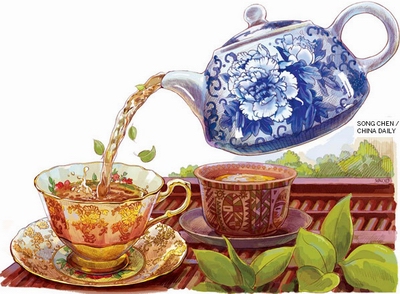What started 5,000 years ago with a haphazard gust of wind dropping foliage into the boiling pot of a wandering Chinese emperor has brewed into a cultural cornerstone worth billions in any currency.

China may be the world's largest tea producer - growing about 2 million tons annually - but international demand for leaves from the country best known for its exports is a fraction of what it produces, with most of the quality product sold domestically.
Although it accounts for more than 40 percent of the tea produced in the world every year, China exports a tiny fraction of the annual crop yield.
Tea producers from countries such as Kenya, India and Sri Lanka dominate the global export market, producing mid- to low-quality teas for mass consumption in the US and Europe.
The reason for China's small portion of the pot is simple - for Western drinkers unaccustomed to the sophisticated process of fine tea appreciation, the price tag of Chinese tea is too steep.
"There is a culture behind Chinese tea that is not found in the West," said Li Zongjian, founder of Lijiang-based tea producer Li Liang Xi, at the recent China Tea Expo in Beijing.
Li, who earned his degree studying the ceremony, growing process and health benefits of tea, says much more goes into Chinese tea than simply creating and consuming.
Perched on a bamboo stool before a meticulously carved wooden serving table, Li is eager to prove his point, theatrically clinking together heated cups as he prepares for a Chinese tea ceremony.
Carefully pinching a dark chunk of Pu'er tea, fermented black tea leaves made famous by China's southern Yunnan province, he holds them under his nose, inhaling deeply.
With a look of satisfaction, he begins preparing the leaves in the way most of the Western world is familiar - boil water, add tea.
But before the brewing process is complete, Li dumps the entire pot of $150 tea into a hidden drain on his serving table - evoking the obvious question "What was the reason for that?"
The first boil only works to awaken the tea leaf, he explains.
This takes place two more times before he serves what he has deemed an appropriate cup of tea according to the gongfucha serving method he spent years perfecting.
"When Chinese people drink tea, they don't consume it like a product. We have tea as a part of our culture, so the standard is high," Li says, continuing his showmanship with an exaggerated sip from the steaming glass.
"For Westerners, it's simply a beverage."
Although it's hard to put a price on culture, Li can sell 100 grams of his hand-picked teas for between $100 and $1,500, depending on the age of the leaves and method by which they were grown - compared with $28 for the same quantity of popular UK tea brand Twinings.
Auction power
While finding someone willing to pay up to four times the price for a block of tea may be difficult, one auction house in Africa has answered the call of tea aficionados from across the globe.
The Mombasa Tea Auction house is one of the most famous in the world, selling teas from across the continent to buyers in the US, Europe and Asia, supplying to big names such as Lipton in a traditional live auction format.
Facing the opposite problem as China - Kenya is the third-largest producer of tea globally, with very little demand domestically - the auction house is now revamping the process to allow international bidders the chance to take part in an e-auction.
The plan is designed to expand the reach of the world's largest tea auction house, matching distributors with buyers at a price both can agree on.
While Western consumers may be perceived as having a less-sophisticated view of tea drinking, the US and Europe are mass consumers - with US citizens alone sipping more than 79 billion servings in 2012, according to statistics from the Tea Association of the USA.
They help fuel an international tea market worth more than $30 billion a year worldwide.
But unlike in China, where tea is the center of many social functions, from gatherings with friends to traditional marriage ceremonies, Americans and Europeans often view it as a cheaper, easy alternative to coffee.
More than 50 percent of the $10 billion annual tea sales in the US last year were ready-to-drink beverages. The pre-prepared bottled tea drinks selling for $1 to $2 a bottle in US grocery stores accounted for $4.8 billion in sales, according to numbers from the Tea Association of the USA.
It was the flourishing success of on-the-go drinks in the US that pushed drinks giant the Coca-Cola to phase out an agreement with Nestle's Nestea last year, instead refocusing efforts to capitalize on the trend in Europe, where traditional teabags still dominate the market.
One report, by research company MarketsandMarkets, estimates that by 2017, ready-to-drink tea and coffee sales will make up a $125 billion global industry.





